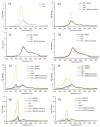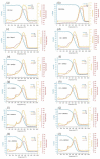Exploring Hydrochars from Lignocellulosic Wastes as Secondary Carbon Fuels for Sustainable Steel Production
- PMID: 37834701
- PMCID: PMC10574071
- DOI: 10.3390/ma16196563
Exploring Hydrochars from Lignocellulosic Wastes as Secondary Carbon Fuels for Sustainable Steel Production
Abstract
This study investigates the suitability of different lignocellulosic sources, namely eucalyptus, apple bagasse, and out-of-use wood, for injection into blast furnaces (BFs). While wastes possess carbon potential, their high moisture renders them unsuitable for direct energy utilization. Additionally, the P and K impurities, particularly in apple bagasse, can pose operational and product quality challenges in BF. Thus, different thermochemical processes were performed to convert raw biomass into a more suitable carbon fuel. Low-temperature carbonization was selected for eucalyptus, yielding a biochar with properties closer to the low-rank coal. Hydrothermal carbonization was chosen for apple bagasse and out-of-use wood, resulting in hydrochars with enhanced fuel characteristics and fewer adverse inorganic species but still limiting the amount in binary PCI blends. Thermogravimetry evaluated the cause-effect relationships between coal and coal- and bio-based chars during co-pyrolysis, co-combustion and CO2-gasification. No synergistic effects for char formation were observed, while biochars benefited ignition and reactivity during combustion at the programmed temperature. From heat-flow data in combustion, the high calorific values of the chars were well predicted. The CO2-gasification profiles of in situ chars revealed that lignin-rich hydrochars exhibited higher reactivity and conversion than those with a higher carbohydrate content, making them more suitable for gasification applications.
Keywords: PCI blends; biomass; biowaste; blast furnace; charcoal; coal injection; combustion; gasification; hydrochar; pyrolysis.
Conflict of interest statement
The authors declare no conflict of interest.
Figures







References
-
- International Energy Agency (IEA) Iron and Steel Technology Roadmap. Towards More Sustainable Steelmaking. Part of the Energy Technology Perspectives Series. 2020; 190p. [(accessed on 13 June 2023)]. Available online: www.iea.org.
-
- World Steel Association World Steel Facts. World Steel in Figures. 2021. [(accessed on 25 September 2021)]. Available online: https://www.worldsteel.org/about-steel/steel-facts.html.
-
- Babich A. Blast furnace injection for minimizing the coke rate and CO2 emissions. Ironmak. Steelmak. 2021;48:728–741. doi: 10.1080/03019233.2021.1900037. - DOI
-
- Birat J.P. Society, Materials, and the Environment: The case of steel. Metals. 2020;10:331. doi: 10.3390/met10030331. - DOI
-
- Diez M.A., Centeno T.A., Amado-Fierro A. Coal use for iron and steel production in low-carbon transition scenarios. In: Osborne D., editor. The Coal Handbook: Towards Cleaner Coal Utilization. 2nd ed. Volume 2. Elsevier; Amsterdam, The Netherlands: 2023. pp. 493–546. Chapter 15. - DOI
Grants and funding
LinkOut - more resources
Full Text Sources
Research Materials
Miscellaneous

